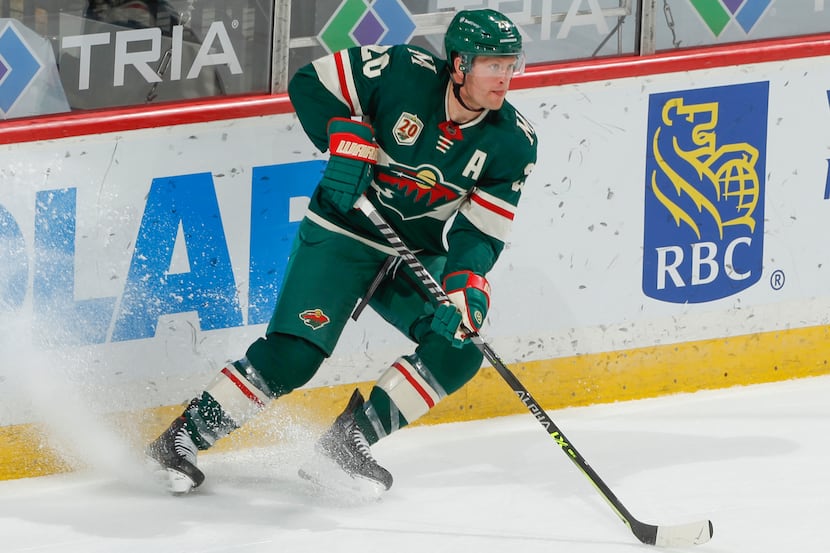The biggest splash the Stars made this summer came on their blue line when they signed defenseman Ryan Suter to a four-year contract worth $3.65 million annually.
The deal carries some risk for Dallas, inking a 36-year-old defenseman to a four-year contract is quite unusual. So is giving that player a full no-movement clause. And doing so strengthened their defensive corps without addressing the need for scoring.
But signing Suter, who was bought out of the final four years of his contract by Minnesota, should give the Stars one of the best blue lines in the league. Suter reliably gave the Wild top-pairing minutes the previous nine seasons while also contributing on both special teams units. He helped unlock Jared Spurgeon’s potential, and served as an alternate captain.
But what else does Suter bring to Dallas besides a veteran presence that doesn’t seem to leave the ice? After watching all seven games of Minnesota’s first-round series against Vegas in May, here are some different and notable areas of Suter’s game.
Defends well with his stick
Suter is not a physical defenseman. He has the size to be one, as he’s listed at 6-1 and 205 pounds, but it’s not part of his game. It’s part of the reason why he’s lasted in the NHL at his age: he doesn’t hit and he doesn’t get hit.
But Suter does a superb job of defending plays with a combination of his positioning and his stick, often breaking up plays with a swipe or a poke. He does it in open ice. He does it along the boards. He does it in front of the net. He does it in the neutral zone.
Take a look at this shift from Game 1 against the Golden Knights. Suter is responsible for foiling a centering pass, slowing the attack behind the net, clearing the zone, disrupting two zone entries and eventually exiting the zone with a pass to Jordan Greenway.
“Just a very, very smart player,” Stars coach Rick Bowness said. “There’s very few mistakes defensively, he protects around his net very, very well. He gets the puck and he moves it quickly and he moves it to the right guy. He makes a lot of very smart decisions with the puck, so he’ll help us defensively. He’s going to help us moving the puck out of our zone. He was a key addition for us.”
Across the entire series, Suter was active in this aspect of his game, knocking Golden Knights off the puck simply by pushing it away from them.
This skill also allows Suter to patrol the net-front without having to be physical. There are certainly times when physicality is needed around the net-front, but tying up sticks instead of trading crosschecks has become an effective way to defend in the front of the net.
Stretch ice with breakout passes
Suter is not going to wow anyone with his skating ability or his hands, especially at 36 years old, so it makes sense that most of his contributions breaking the puck out of his own zone came passing the puck instead of toting it.
Suter helped create multiple breakaways for the Wild during the seven-game series against Vegas as he found stretch passes through the teeth of the defense.
It’s something that helped offset the fact that he rarely carried the puck himself out of the defensive zone. Instead, that responsibility fell to Spurgeon, who darted through the neutral zone in attempts to enter the offensive zone.
When thinking about Suter’s potential partners in Dallas, there’s really only two options: John Klingberg and Miro Heiskanen. Bowness and the Stars will take training camp to fiddle with forward lines and defensive pairs, but both players offer Suter the familiar ability to carry the puck into the offensive zone.
Klingberg may be a more natural fit as someone whose risk profile more closely resembles Spurgeon’s in addition to being a right-handed complement to Suter’s left-handed shot.
“Spurgeon is only able to do that because of Ryan,” Bowness said. “Ryan knew how to back him up and Spurgeon had the confidence that Ryan would back him up. Spurgeon was far more involved offensively only because he knew who his partner was, that his partner would back him up.
“With Miro and John, two key offensive guys and a big part of our attack, it’ll be about the same thing. We want Ryan to jump up because Ryan’s very good offensively and he’s got good offensive instincts.”
Picks his spots offensively
Just because Suter does not factor heavily in transition himself, that does not mean he can be written off on the offensive end of the ice. Prior to last season, he posted three straight years of at least 40 assists. Even if 50 of the 125 assists came on the power play, Suter still produced at even-strength.
That production was not there last year (19 points in 56 games) and it may not return at this stage in Suter’s career, but the decision-making in the offensive zone is often sound, reading plays and figuring out when to shoot, pass or pinch in the offensive zone.
He does a good job of finding the middle of the ice, either as an option himself or sometimes deferring to Spurgeon taking available space in the high slot. Suter also reads well off Spurgeon’s decision-making in the offensive zone, staying at the blue line while his partner is deep and then sometimes sneaking lower for a prime chance.
Suter ran the point on the Wild’s second power-play unit, but it’s unknown how the Stars will use him on the man-advantage. With Klingberg and Heiskanen, the Stars have two capable defensemen that can run power plays, meaning one of them would have to move from the point to create space for Suter.
“On the power play, you notice that he’s very good at getting pucks to the net,” Bowness said. “His eyes are up, he’s moving, he gets his shots through. He takes a lot of wristers. I remember coaching the penalty kill against Minnesota, you always had to be aware when Ryan had the puck, you know he was very, very good at getting pucks to the net.”
Last year, Heiskanen spent a fair amount of time in the right circle on the same unit as Klingberg, so it’s possible the Stars opt to return Heiskanen to the flank. But Dallas also has a surplus of players that can play that position on the power play (Denis Gurianov, Alexander Radulov and Jason Robertson being the prime candidates).
Kills a lot of penalties
Suter was a mainstay on the Wild penalty kill and he was often on the ice for the first faceoff of the power play.
Last year, he played 111:01 of shorthanded time on the ice according to Natural Stat Trick, 58th-most among NHL defensemen. Among the 74 defensemen that played at least 100 shorthanded minutes last season, Suter was one of the best at suppressing goals. The Wild allowed 3.83 fewer goals per 60 minutes with Suter on the ice on the PK than with him off the ice. That figure for Suter was second in the league.
It also helps that Suter is usually not in the penalty box, allowing him to kill penalties. In the last two seasons, Suter has been called for 12 total minor penalties.
In Dallas, Suter could make sense as Lindell’s partner to begin penalty kills, a job previously held by Andrej Sekera. The Stars could also look to use Suter alongside Heiskanen or new addition Jani Hakanpää on the PK.
Susceptible to neutral zone mistakes
Because Suter is so skilled with his stick and because he wants to pass his way through the neutral zone, it can be problematic sometimes. A missed challenge results in an odd-man rush, or a turnover winds up in the back of the net.
It happened a few times to Suter against the Golden Knights, including a brutal sequence in Game 7 in Vegas when Minnesota was already down two goals.
Errors like these are bound to happen to defensemen that play as much as Suter does, and to defenseman that handle the puck as much as Suter does. The concern comes when Suter takes the same risks he’s been taking his entire 16-year career, but it’s just a little bit slower. Across the life of a four-year contract, that’s certainly possible.
Occasional aimless passes prolong possession
These mistakes were few in the first-round series against Vegas, but noteworthy since they extended the Golden Knights’ zone time and created more scoring chances. At times, Suter threw pucks up the boards to no one in particular, allowing Vegas to collect it and retain possession when Minnesota should have been out of the zone.
Much like the previous point, these things will happen to defensemen that handle the puck a lot. The key is managing how often those mistakes happen.
+++

